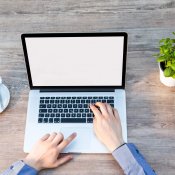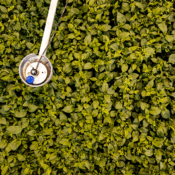Here’s what we’ve learned from 50+ IoT customers
Earlier this month, I spoke at the UK Anaerobic Digestion and Biogas World Expo in Birmingham, as part of a panel on the importance of real-time monitoring and data capturing. Our panel addressed industrial and agricultural organizations of various sizes with an interest in sustainability, biogas and waste management.
It can be challenging addressing IoT concepts when you have a diverse audience— there’s no one-size-fits-all approach to capturing sensory data from the physical world, and use cases can really vary.
When you’re measuring and optimizing the physical environment, every project is different: each organization comes with different needs, challenges, and existing ecosystems. At 30MHz, we’ve seen our customers across sectors cut costs, drive productivity and create data-driven cultures around the measurement of physical space. We’ve learned a lot from the companies who’ve implemented smart sensing in their environments. From agriculture to space utilization, manufacturing to smart city, we’ve observed a few recurring themes, some universal lessons.
As I shared with the audience at AD & Biogas World Expo, here’s what more than 50 customers have taught us about smart sensing in industry:
Smart sensing doesn’t have to be complicated (or expensive)
Getting immediate value out of the monitoring of physical space (we call it smart sensing) is easy when the product is intuitive to deploy, with little overhead. While consultants certainly have their place in the greater landscape of digitization, they shouldn’t be critical to the deployment of a wireless sensor network. Customers are busy enough trying to maximize their productivity, they don’t have time to for expensive “solutions” with long setup times and steep learning curves. From deployment to daily use, sensing technology needs to be pragmatic and easy to use.
Customers don’t want to give up control
And they shouldn’t have to. Smart sensing is a process, a new approach to physical assets and locations. Customers want the control and flexibility to implement smart sensing exactly as they need it. They want to decide on the combination of sensors they measure with, how their dashboards display information, the conditions under which they receive real-time alerts, where smart sensing integrates with other technologies and the pace of scale. That’s why we’ve built the 30MHz Sensor Toolkit as a standalone product, with the all the modular pieces of a smart sensor network designed to mix, match and build on top of as customers’ needs evolve. And because we know that information is an organization’s most precious asset, we make sure customers are sole proprietors of their sensory data.
It’s okay to start small— you can still get results
As a business, you don’t need to deploy sensors in the hundreds to get meaningful insights on your environment. Of course, the more sensors you work with, the more granular your insights, but strategic placement of even a small number of sensors can provide significant ROI. One of our customers, a commercial pepper farm, has seen an estimated ROI of about 3600% with only just a few pointed temperature sensors placed throughout a greenhouse.
Despite the near universal hype around the Internet of Things (IoT), smart sensing is still a new technology. Starting with a small project (that deploys in minutes) makes it easier for organizations to justify their investment, see results and scale.
Sensors must be ready for industrial conditions
Smart sensing for industry requires reliable connectivity and sensors that can withstand harsh environments. We’ve seen the importance of readiness for industrial conditions working with customers like the Port of Amsterdam. Ask any engineer, a bustling port might be one of the most challenging settings for a wireless sensor network. A busy port requires continuous uptime despite water, wind, gull droppings and constant ship traffic. We’ve made certain that our sensors are designed to weather the elements, on a network that guarantees stability. Our sensors are built to guarantee accurate readings even in high humidity, UV-light, and extreme temperatures.
Real-time metrics can prevent large scale losses
When business critical metrics are on the line, staying up to date in real-time is non-negotiable. Continuous monitoring enables businesses to anticipate maintenance needs, quickly observe and respond to anomalies, and intervene to prevent losses. Jan de Wit & Zonen use smart sensing technology to monitor the entire process of flower bulb cultivation and processing, using insights from wind sensors, temperature and humidity sensors and ethylene sensors to control and optimize the growth, ventilation, drying, and storage of their products. These insights prevent expensive product loss from bulb rot and molding. Moors Pepper Farm prevents product loss by optimizing water and nutrient delivery based on real-time data on the vegetables’ surface temperature.
Data is stronger together
To maximize the power of data, organizations need to free it from silos. Metrics captured by various sensors, wireless devices, and third party systems are most helpful for decision making when they’re analyzed together. That’s why it’s crucial that businesses have the freedom and flexibility to export and combine their data. Our customers use the 30MHz API to connect physical data to other technologies, and the Sensor Toolkit makes it easy to connect any sensor to our dashboard.
You’re not stuck in one place
When you’re analyzing and optimizing physical space, don’t remain limited to a single location. Monitor, benchmark, compare and optimize multiple locations in one centralized dashboard. Our customers get alerts and analytics from multiple locations, whether they’re greenhouses, plants or factories. We’re proud to have 30MHz sensors monitoring assets and environments in areas as diverse as Canada, the Netherlands, Kenya, and Australia.
Augment human ingenuity, don’t replace it
The world may be heading towards automation, but that doesn’t mean you need to automate every task. Farmers, engineers, and plant managers are experts and doing their jobs, all they need is the most relevant and accurate data to help guide their decisions. Though smart sensing can certainly be complementary to automation, real-time measurement–especially from areas that are difficult to reach and measure manually–can amplify human innovation. Our agricultural customers see this: rather than focusing on automation for automation’s sake, they look for the ROI of technology: improving the accuracy of human work, cutting costs, and improving safety, efficiency, and sustainability. Sensor technology doesn’t replace humans in agribusiness, it provides the time to focus on important tasks that might otherwise be neglected due to limited resources.
No business is too large or too small for smart sensing
Whether you’re a multinational or a growing agribusiness, sensory data can help you make more informed, data-driven decisions. Businesses of all sizes have used the 30MHz get insights from the real world and transform their operations. Budget, team size, and existing tech ecosystem don’t need to be barriers to smart sensing.
If there’s one thing we’ve learned working with 50+ smart sensing customers, it’s that there’s no better R&D lab than real companies using your product. We’re not interested in the hype of IoT, we’re building real products that we know customers in agriculture and industry want and need. We developed many of our sensors in collaboration with our customers, and we’re always looking to join forces with innovative organizations. Do you see an opportunity for sensory data to transform how work gets done in your industry? Let us know what you’d measure.
Joanna Madej is responsible for marketing and communications at 30MHz


30MHz is typing… Our extended support team is ready to chat!
At 30MHz we think it’s important that our users can use our platform in an optimal way. At times you may have questions and you would like some help from our support team. Email and our support page filled with helpful articles were your go to’s. But we thought it was time for something extra… ...Read more
New 30MHz connect casing: How we protect your tech
To make sure your dataflow is fully protected, 30MHz introduces a new connect casing: waterproof, dust proof and even resistant to hits. This special shield will last longer and ensure a reliable dataflow from the connected sensor. What does that full protection mean? That’s what we will explain in this article. Watertight: resistant to wetness ...Read more
Most popular sensors for your greenhouse
As a grower, you know that optimal crop development starts with precise monitoring of your cultivation environment. But how do you transform raw data into actionable insights for your crops? This is where our wireless sensors and the 30MHz platform come together. Our sensors measure essential variables such as VPD, dew point, moisture deficit, EC, ...Read more


